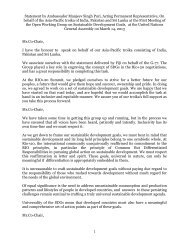STATE OF THE WORLD'S CITIES 2012/2013 Prosperity
STATE OF THE WORLD'S CITIES 2012/2013 Prosperity
STATE OF THE WORLD'S CITIES 2012/2013 Prosperity
You also want an ePaper? Increase the reach of your titles
YUMPU automatically turns print PDFs into web optimized ePapers that Google loves.
Chapter 1.2<br />
Urban and<br />
Regional Trends<br />
MORE THAN HALF <strong>OF</strong> <strong>THE</strong> WORLD IS NOW URBAN<br />
It is really remarkable that only one century ago, two<br />
out of 10 people in the world were living in urban areas.<br />
In the least developed countries, this proportion was<br />
as low as five per cent, as the overwhelming majority<br />
was living in rural areas. The world has been rapidly<br />
urbanizing since then and, in some countries and regions,<br />
at an unprecedented pace. It was only two years ago that<br />
humankind took a historic step when, for the first time<br />
in history, the urban outnumbered the rural population.<br />
This milestone marked the advent of a new “urban<br />
millennium” and, by the middle of this century, it is<br />
expected that out of every 10 people on the planet, seven<br />
will be living in urban areas.<br />
Interestingly, only 60 years ago or so (1950), the<br />
number of people living in urban centres was slightly<br />
higher in the developed nations (54 per cent, or 442<br />
million) compared with developing countries. Today,<br />
of every 10 urban residents in the world more than<br />
seven are found in developing countries, which are also<br />
hosts to an overwhelming proportion of humankind<br />
(82 per cent of the world’s population). Moreover, it is<br />
estimated that, between 2010 and 2015, some 200,000<br />
people on average will be added to the world’s urban<br />
population each day. Worth noting is that 91 per cent of<br />
this daily increase (or 183,000) is expected to take place in<br />
developing countries.<br />
25<br />
Urban Change in<br />
Developed Countries<br />
URBAN POPULATION GROWTH IS NExT TO<br />
STAGNANT<br />
In the more advanced nations, urban population growth<br />
is next to stagnant (0.67 per cent on an annual average basis<br />
since 2010), which represents an additional six million or<br />
so every year. In Europe, the annual increase is only two<br />
million. By comparison, the aggregate annual population<br />
increase in six major developing-country cities – New Delhi<br />
and Mumbai (India), Dhaka (Bangladesh), Lagos (Nigeria),<br />
Kinshasa (Democratic Republic of Congo) and Karachi<br />
(Pakistan) – is higher than Europe’s entire population.<br />
Population in North American cities was the least slow of<br />
all those in the developed world between 2005 and 2010,<br />
particularly in the United States (one per cent on average).<br />
The Growth, Decline and <strong>Prosperity</strong> of Cities: There<br />
is no clear association between the demographic growth or<br />
decline of cities and their degrees of prosperity. Although<br />
population numbers have declined in a number of cities in<br />
Western Europe, Canada and New Zealand, this did not<br />
affect living standards, which in some cases even improved.<br />
On the other hand, and<br />
as might be expected,<br />
population declines in<br />
a number of cities in<br />
Eastern Europe and the<br />
United States of America<br />
are strongly associated<br />
with economic decay. The<br />
deterioration of inner<br />
city conditions (deserted<br />
FACT<br />
In the last<br />
20 years,<br />
the proportions of<br />
European cities with<br />
demographic growth<br />
rates over one per cent<br />
and of those with<br />
population declines<br />
were comparable.


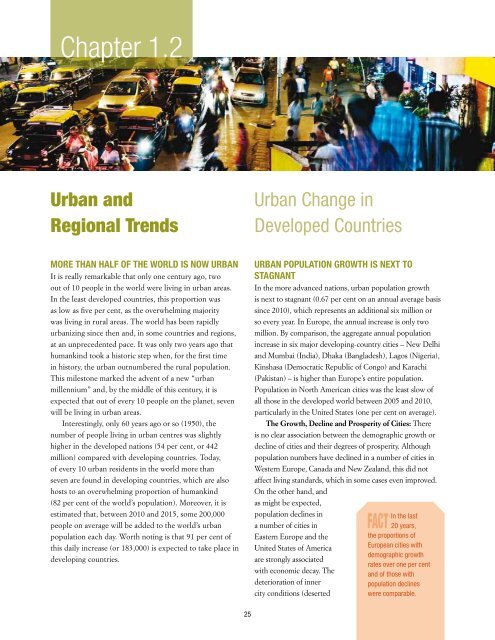

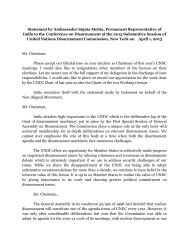

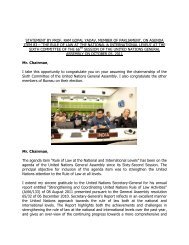
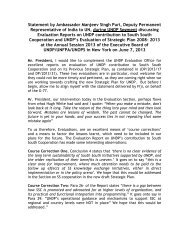


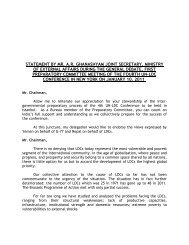


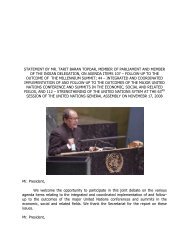
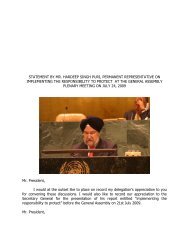
![1 statement by dr.[mrs] kakoli ghosh dastidar - Member States Portal](https://img.yumpu.com/27526598/1/190x245/1-statement-by-drmrs-kakoli-ghosh-dastidar-member-states-portal.jpg?quality=85)
